Você já tentou fazer upload de um arquivo para o seu site WordPress e se deparou com um obstáculo? É muito frustrante quando você não consegue carregar a imagem, o plug-in ou o tema de que precisa. Nossos leitores frequentemente nos pedem ajuda com problemas de upload de arquivos, pois eles podem atrapalhar seu fluxo de trabalho.
Às vezes, esses limites de upload de arquivos podem impedi-lo inesperadamente de adicionar conteúdo à sua biblioteca de mídia ou de instalar os plug-ins e temas maiores de que você precisa. É como estar de mãos atadas. E é ainda mais irritante quando você não sabe como resolver isso!
Mas não se preocupe, estamos aqui para ajudar. Adoramos o fato de o WordPress ser uma plataforma tão configurável, e muitas vezes há várias maneiras de resolver o mesmo problema.
Neste guia, mostraremos a você as maneiras mais fáceis de aumentar o tamanho máximo de upload de arquivos no WordPress. Vamos ajudá-lo a superar essas limitações para que você possa voltar a fazer o que gosta: administrar seu site!
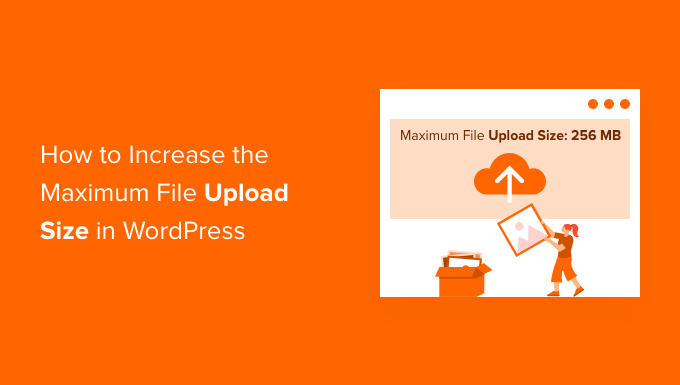
Por que aumentar o tamanho máximo de upload de arquivos no WordPress?
Seu provedor de hospedagem WordPress definirá um tamanho máximo de upload de arquivo padrão quando você se inscrever e instalar o WordPress. Seu provedor de hospedagem define esse limite, que geralmente varia de 2 MB a 500 MB.
Para a maioria dos proprietários de sites WordPress, esse limite será mais do que suficiente.
No entanto, há ocasiões em que você precisará aumentar esse limite para não ter erros de upload.
Por exemplo:
- Você administra um site de fotografia e precisa fazer upload de imagens grandes.
- Seu portfólio de design ou fotografia tem imagens grandes.
- Você deseja instalar um tema ou plug-in maior do WordPress.
- Você deseja vender produtos digitais, como livros eletrônicos, fotos, vídeos e muito mais.
- Você atualiza regularmente o conteúdo e adiciona áudio, fotos e outros itens que estão além do limite atual.
Dito isso, vamos mostrar como você pode aumentar o tamanho máximo de upload de arquivos em seu site WordPress.
Observação: lembre-se de que a exibição de muitos arquivos grandes em seu site pode reduzir seriamente a velocidade e o desempenho dele. É por isso que normalmente recomendamos nunca fazer upload de vídeos para o WordPress.
Como a maioria dos usuários tem diferentes configurações de hospedagem do WordPress, abordaremos o seguinte:
- How to Check Your Maximum File Upload Size Limit in WordPress
- Method 1: Contact Your WordPress Hosting Provider
- Method 2: Create or Edit an Existing php.ini file
- Method 3: Add Code to Your WordPress Theme functions.php File
- Method 4: Add Code to Your .htaccess File
- Method 5: Use a WordPress Plugin to Increase File Upload Size
Como verificar o limite máximo de tamanho de upload de arquivos no WordPress
O WordPress mostrará automaticamente o limite máximo de tamanho de upload de arquivos quando você estiver fazendo upload de imagens ou outras mídias.
Para verificar isso, basta ir para Mídia ” Adicionar novo no painel de administração do WordPress e você verá o limite máximo de tamanho de upload de arquivo para o seu site WordPress.
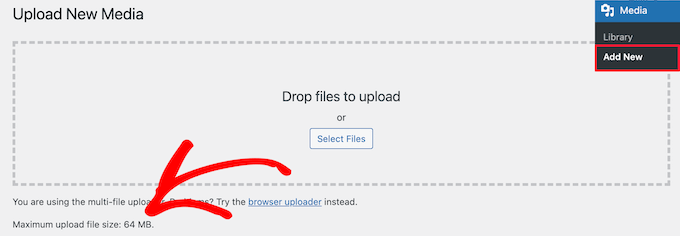
Agora que você sabe como encontrar o limite de tamanho, vamos mostrar como aumentar o tamanho máximo de upload no WordPress.
Método 1: Entre em contato com o provedor de hospedagem do WordPress
Uma das maneiras mais fáceis de aumentar o tamanho máximo de upload de arquivos no WordPress é entrar em contato com o provedor de hospedagem do WordPress.
Essa é uma tarefa relativamente simples para a equipe de atendimento ao cliente e pode ser feita em alguns minutos.
Para iniciantes, isso pode ser muito mais fácil do que adicionar código ao WordPress e editar arquivos do servidor.
Basta acessar o site do seu provedor de hospedagem, como a Bluehost, e fazer login.
Em seguida, clique no ícone “Chat” na parte inferior da tela. Em seguida, você pode solicitar à equipe de suporte que aumente o tamanho do upload de arquivos em seu site do WordPress.
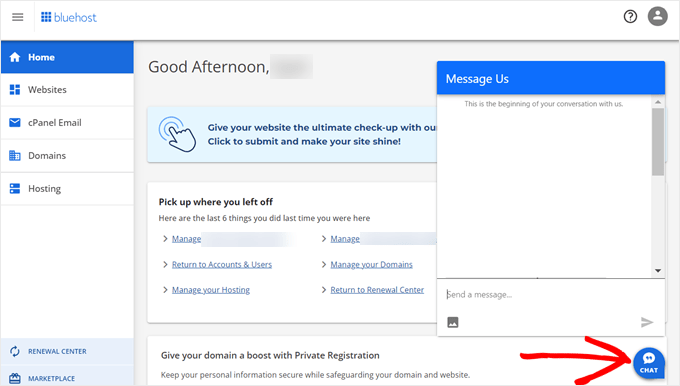
Você também pode entrar em contato com o suporte no painel da sua conta de hospedagem.
Método 2: Criar ou editar um arquivo php.ini existente
Outra maneira de aumentar o tamanho máximo de upload de arquivos é criar ou editar um arquivo chamado php.ini. Esse arquivo controla várias configurações do seu ambiente de hospedagem do WordPress.
A maioria dos provedores de hospedagem WordPress, como a Bluehost, tem um cPanel amigável para iniciantes para ajudar a gerenciar seu site.
Se o seu host da Web tiver um painel cPanel, você poderá aumentar o tamanho do upload de arquivos por meio das ferramentas integradas.
Observação: o texto a seguir foi extraído do cPanel da Bluehost. No entanto, a maioria dos provedores de hospedagem compartilhada terá etapas semelhantes.
Você encontrará um botão do cPanel na parte inferior da guia Hosting na Bluehost.
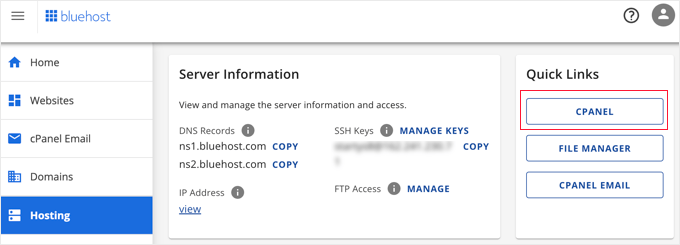
Clicar nesse botão abrirá o painel do cPanel.
Agora você precisa rolar para baixo até a seção Software e clicar em ‘MultiPHP INI Editor’.
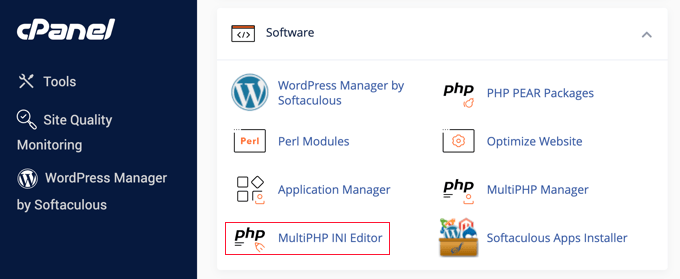
Em seguida, role para baixo até a seção denominada ‘upload_max_filesize’ e insira um novo tamanho máximo de arquivo na caixa.
Em seguida, clique no botão “Apply” (Aplicar).
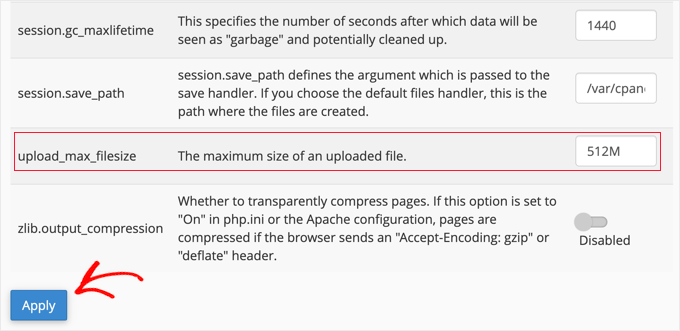
Como alternativa, você pode clicar na guia do menu “Editor Mode” e alterar o tamanho máximo de upload de arquivos diretamente no editor.
É necessário editar a seção “upload_max_filesize” para aumentar o tamanho do upload do arquivo.
Quando terminar, basta clicar no botão “Salvar”.
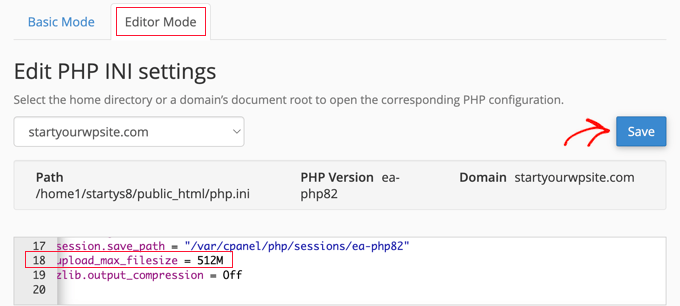
Editar o php.ini adicionando código
Se o seu provedor de hospedagem atual não oferecer a opção cPanel, você precisará editar esse arquivo manualmente.
Para isso, você pode usar um cliente FTP ou a opção de gerenciador de arquivos no painel de controle da hospedagem do WordPress.
Se você estiver usando hospedagem compartilhada, talvez não veja o arquivo php.ini no diretório de hospedagem. Se não encontrar um, basta criar um arquivo chamado php.ini e carregá-lo em sua pasta raiz.
Em seguida, adicione o seguinte trecho de código ao arquivo:
upload_max_filesize = 256M
post_max_size = 256M
max_execution_time = 300
Você pode modificar o limite de “256M” para o tamanho de arquivo necessário para o seu blog do WordPress.
Método 3: Adicionar código ao arquivo functions.php do tema do WordPress
Esse método envolve a adição de código ao arquivo functions.php em seu tema do WordPress.
Em vez de editar o arquivo diretamente, recomendamos o uso do WPCode. É o melhor plug-in de snippets de código que permite adicionar código ao seu site sem quebrá-lo.
Se você nunca fez isso antes, consulte nosso guia para iniciantes sobre como adicionar código personalizado no WordPress.
Primeiro, você precisa instalar o plug-in gratuito WPCode. Para obter mais detalhes, consulte nosso guia passo a passo sobre como instalar um plug-in do WordPress.
Após a ativação, você deve navegar até Code Snippets ” + Add Snippet.
Você precisará passar o mouse sobre a opção “Add Your Custom Code (New Snippet)” e, em seguida, clicar no botão “+ Add Custom Snippet”.

Em seguida, você precisa escolher “PHP Snippet” como o tipo de código na lista de opções que aparece.
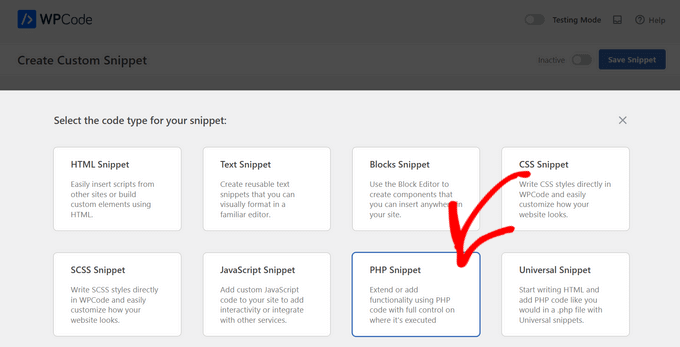
Na tela seguinte, digite um nome para o novo snippet, que pode ser qualquer coisa que o ajude a lembrar para que serve o código.
Em seguida, você pode copiar e colar o seguinte trecho de código em “Code Preview” (Visualização de código). Certifique-se de alterar “256M” para o tamanho máximo de arquivo que você precisa:
@ini_set( 'upload_max_size' , '256M' );
@ini_set( 'post_max_size', '256M');
@ini_set( 'max_execution_time', '300' );
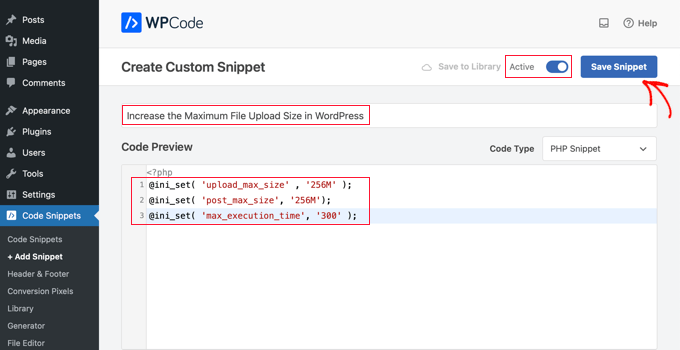
Por fim, alterne a alternância na parte superior para “Active” (Ativo) e, em seguida, clique no botão “Save Snippet” (Salvar snippet). O código agora será executado em seu site.
Método 4: Adicionar código ao seu arquivo .htaccess
Outra maneira de aumentar o tamanho máximo do arquivo é modificar o arquivo .htaccess. Esse arquivo controla as definições de configuração de alto nível do seu site.
Para fazer isso, é necessário fazer login no servidor do site via FTP. Se você nunca fez isso antes, consulte nosso guia sobre como usar o FTP para fazer upload de arquivos no WordPress para iniciantes.
Depois disso, você precisa localizar o arquivo .htaccess na pasta raiz do seu site.

Se você não conseguir encontrar o arquivo .htaccess, ele pode estar oculto pelo gerenciador de arquivos ou pelo cliente FTP. Para saber mais, consulte nosso guia sobre por que você não consegue encontrar o arquivo .htaccess em seu site WordPress.
Em seguida, você precisa adicionar o seguinte trecho de código ao seu arquivo .htaccess:
php_value upload_max_filesize 256M
php_value post_max_size 256M
php_value max_execution_time 300
php_value max_input_time 300
Para aumentar ainda mais o tamanho máximo de upload de arquivos, basta alterar o valor “64M” para o tamanho desejado.
Método 5: Use um plug-in do WordPress para aumentar o tamanho do upload de arquivos
Outra maneira de aumentar o limite máximo de upload de arquivos é usar o plug-in WP Increase Upload Filesize. Se você não se sente à vontade para adicionar código ao WordPress, essa pode ser uma boa opção para você.
A primeira coisa que você precisa fazer é instalar e ativar o plug-in. Para obter mais detalhes, consulte nosso guia sobre como instalar um plug-in do WordPress.
Após a ativação, navegue até Mídia ” Aumentar limite de upload no painel de administração do WordPress.
Isso o leva a uma tela em que você pode selecionar um novo tamanho de upload de arquivo no menu suspenso ‘Choose Maximum Upload File Size’.
Em seguida, clique no botão “Save Changes” (Salvar alterações).

Observação: o tamanho máximo de upload de arquivos será definido pelo seu provedor de hospedagem. Se precisar de um limite de tamanho de arquivo maior do que o listado no menu suspenso, será necessário entrar em contato com o provedor de hospedagem e solicitar o aumento do limite.
Tutorial em vídeo
Se você não gosta de seguir instruções escritas, pode conferir nosso tutorial em vídeo:
Esperamos que este artigo tenha ajudado você a aumentar o tamanho máximo de upload de arquivos no WordPress. Talvez você também queira ver nosso guia sobre como adicionar tipos de arquivos adicionais para upload no WordPress e nossas escolhas de especialistas de plugins e dicas para melhorar a área de administração do WordPress.
Se você gostou deste artigo, inscreva-se em nosso canal do YouTube para receber tutoriais em vídeo sobre o WordPress. Você também pode nos encontrar no Twitter e no Facebook.





Lisha Van Nieuwenhove
This help was BRILLIANT. THANK YOU!
WPBeginner Support
You’re welcome!
Admin
Ray Konopka
Thanks for the tips. My site is hosted in BlueHost so I first tried Method 2. However, after changing the upload_max_filesize value, the Add New media page for my site still showed 64 MB. I went back into the MultiPHP INI Editor and looked at the other values. One other value stood out:
post_max_size
Sets max size of post data allowed. This setting also affects file upload. To upload large files, this value must be larger than upload_max_filesize. Generally speaking, memory_limit should be larger than post_max_size.
After I increased the post_max_size value as well, then the Add New media upload page showed the new limit. Perhaps you can update the post to include this tip.
WPBeginner Support
Thank you for sharing this, we’ll be sure to look into it and possibly add it to the article in the future
Admin
Mark
All my limits were increased as suggested, but I started getting ‘files are too big’ after a plugin update. After double checking everything server and email side, the solution was changing from 5M to 5120kb in Contact Form 7 settings. The plugin suddenly stopped recognizing M when trying to override the default 1024kb setting.
WPBeginner Support
Thanks for sharing this should someone else run into this issue!
Admin
devshah
Function.php method is not Working.
WPBeginner Support
It would depend on your host and what else is set up on your server for what will work. If nothing else works you can always reach out to your host for assistance.
Admin
Halil AHMAD
The .htaccess worked for me. Thank you
Muzoora Barnabas
The .htaccess worked for me. Thank you
WPBeginner Support
Glad our recommendation was able to assist
Admin
Muhammad Farooqi
You comments and thanks secion is almost 10 times longer..than the content of this page is guarantee of your amazing tips
WPBeginner Support
We’re happy we can help so many WordPress users
Admin
Jacob Alas
The only method that worked for me was: htaccess Method
Thank you.
WPBeginner Support
Glad one of our methods was able to work for you
Admin
Daniyar Nauryz
htaccess Method has worked for me.
WPBeginner Support
Glad our recommendation worked for you
Admin
furqan
its not working.
WPBeginner Support
If the recommendations are not working for you, we would recommend reaching out to your hosting provider and they should be able to assist if this is something they’ve set on their end.
Admin
Abdullah Ashraf
Thank you so much. I tried all the methods and the last method was helpful for me.
I would like to know should I undo the second last step that was php.ini?
WPBeginner Support
It is not required to remove that file but you can remove it if it is not working for your server.
Admin
Bradley
None work.
WPBeginner Support
If none of our recommendations work, we would recommend reaching out to your hosting provider to see if it is a restriction that they have set on their servers.
Admin
Ben
If you have access to the FTP, can I just upload the file in the wp-content/uploads/[year]/[month] folder?
WPBeginner Support
If you do that you would need a plugin to find the images, we have a guide on how to do that below:
https://www.wpbeginner.com/plugins/how-to-bulk-upload-wordpress-media-files-using-ftp/
Admin
naved ahmed
Thanks a lot
.htaccess method worked for me.
You saved my lot of time.
Thanks again.
WPBeginner Support
Glad our guide was able to help you
Admin
Adio Usman
Does this method works for restoring backup that is up to 3.5gb manually?
WPBeginner Support
It would depend on the method you are using but it could help with restoring a backup that large.
Admin
viren
method 3 is perfectly worked for me.keep inspiring us.great work man.thnks
WPBeginner Support
Glad our recommendation was helpful
Admin
ayman
.htaccess methode worked with me
WPBeginner Support
Glad our recommendation was helpful
Admin
Sanchit Setia
Does this work on free hosting?
WPBeginner Support
You would want to check with your hosting provider if you are concerned
Admin
bara
It works for me
WPBeginner Support
Glad our recommendation helped you
Admin
abc
nothing is working for lms
WPBeginner Support
If none of the recommendations worked we would recommend reaching out to your hosting provider for assistance.
Admin
Ahmad
I tried this but the size did not change… status is same please help what should I do know I am using localhost
WPBeginner Support
You would want to try restarting your localhost service just in case, otherwise, you would want to ensure you added/editied the php.ini correctly for the most common reason.
Admin
Vittorio
I think
@ini_set( ‘upload_max_size’ , ’64M’ );
should be
@ini_set( ‘upload_max_filesize’ , ’64M’ );
WPBeginner Support
upload_max_size currently increases that value as well as a few other things which is why we don’t use upload_max_filesize
Admin
MFoale
Thank you. The 3rd method worked for me. Very useful post and video.
WPBeginner Support
You’re welcome, glad we were able to help
Admin
Masud Rana
Wow !its work. Thanks
WPBeginner Support
Glad our guide could help you
Admin
Oliver
IT WORKS!!! THANKS
I made a file ini.php then uploaded it, then renamed it from ini.php.txt to ini.php and it worked.
thanks
WPBeginner Support
You’re welcome, glad our guide was able to help
Admin
Brad
None of these works
WPBeginner Support
If our recommendations do not work you would want to reach out to your hosting provider to ensure they do not have it as part of their settings.
Admin
Arivazhagan
Method 2 worked for me thanks a lot ive been struggling with this for two days …
WPBeginner Support
You’re welcome, glad our recommended solution was able to help you
Admin
Sujan Chakraborty
you are great.I fix my problem by reading you post.Tnx
WPBeginner Support
Glad our article could be helpful
Admin
Krakawid
Method 3 worked
WPBeginner Support
Glad our recommendation worked for you
Admin
Tung
Method 1 worked wonders for me. Thanks a bunch!
WPBeginner Support
You’re welcome, glad our recommendation worked for you
Admin
Trasadu
Thanks Method 3 really worked for me.
WPBeginner Support
Glad our recommendation was helpful
Admin
Asad
How can i increase the upload limit while i have the wordpress hosting also functions.php isn’t updating
WPBeginner Support
If the file will not update, you would want to reach out to your hosting provider and they should be able to assist
Admin
Chris
I want to increase the limit to 250mb but i dont know if this exposes my site to security treats, though am only using gravity form and I have also set to disable php execution on my upload folder. And have allowed only jpg, and mp3 files.
Please do you think this may affect my site load times as huge upload is coming from several users?
WPBeginner Support
If multiple users attempt uploads at the same time it can have an effect on your site’s load time but it shouldn’t open you to security threats
Admin
Vinod
Thanks a lot!!! Method 3 worked for me
WPBeginner Support
Glad our recommendation worked for you
Admin
Janice
Nice article, but I tried adding your 3 lines of code to the functions.php file, but got an “unknown @ rule” error. What’s that all about?
WPBeginner Support
It would depend on the entire error but it could have been a hiccup with how the code was inserted, you may want to take a look at our guide here: https://www.wpbeginner.com/beginners-guide/beginners-guide-to-pasting-snippets-from-the-web-into-wordpress/
Admin
Abduaziz
Thanks a lot!!! Method 3 worked for me
WPBeginner Support
Glad our recommendation could help
Admin
Alexander Gartley
Thanks, this helped me troubleshoot an upload limit. I’m on a WordPress multisite network install, so it ended up being a setting in the Network Admin Settings.
I was confused at first, because my php settings were allowing larger uploads, but it was restricted in the Network Settings.
WPBeginner Support
Thanks for sharing what solved the problem for you
Admin
Ernesto
Would have been great if you have included the .user.ini method.
.user.ini uploaded in the root folder with the same value/text in your edited php.ini
Most of the time, only this method works for shared hosting.
ErnestPH
WPBeginner Support
The php.ini file should work the same as the user.ini file unless your specific host ignores the php.ini but thank you for sharing your recommendation
Admin
Mark
This is the only solution that works on my shared hosting server. Thanks Ernesto!
Tamir Davidoff
Not working for me.
I have followed this guide and double checked the php.ini file to make sure that the changed are in fact saved. changed htaccess file to increase limits. and also tried modifying the phpMyAdmin httpd-app.conf and php-settings.conf file. All of these files reflect max upload higher than 40m and my WP site does not reflect Any of these changes. Really frustrated here.
Please help me, thanks !
WPBeginner Support
If you haven’t already, you would want to reach out to your hosting provider to ensure there is not a setting on their end that is overriding what you are setting
Admin
rajesh
i have tried all 3 method none of them worked. i am trying to upload newspaper theme in my in my wordpress site. but every time it show that php.ini file upload max file size.
plz help me
WPBeginner Support
You would want to reach out to your hosting provider to ensure they don’t have a setting that is overriding the changes you made.
Admin
Adam Walsworth
Watchout for hidden php.ini files. In my setup I found 2 of them. The one which I found actually resolved the issue was found under
./etc/php/7.0/apache2/php.ini
modifying this file fixed my issue.
WPBeginner Support
Thanks for sharing your solution, with where that file is located we would recommend most users reach out to their hosting provider before looking in locations like that.
Admin
Rafiq khan
Thanks buddy i have solved my problem by adopting method 2 by editing my php.ini file
Thanks alot you are working great
WPBeginner Support
Glad our article could help
Admin
Carla
None of the above worked for me. A matter of fact, editing the htaccess file broke my site even after deleting the above code. Overwriting with a new file fixed the problem though.
I have a dedicated server on Bluehost. What worked for me was going in the WHM root, not cpanel nor FTP access. Search for MultiPHP INI Editor. Give it at least 5 minutes to load if you only see the title and icon. You can set you upload time, post size, etc. there. Works instantly, even if your site is using Cloudflare, without placing it in development mode or clearing the cache. I hope this helps someone.
WPBeginner Support
Thank you for sharing what worked for you, should other users be on a dedicated server, if they reach out and let BlueHost know the need to increase the upload size then BlueHost can normally edit that for them
Admin
Pezza
Great Stuff! .htaccess worked for me!
WPBeginner Support
Thank you, glad our guide could help
Admin
ReineR
htaccess metod worked for me, thanks!
WPBeginner Support
Glad our article could help
Admin
Ahmed
Work for me
3. htaccess Method
you need to click (show hidden files to view and edit this file).
WPBeginner Support
Glad our article could help
Admin
rahul
when i tried this
Unable to communicate back with site to check for fatal errors, so the PHP change was reverted. You will need to upload your PHP file change by some other means, such as by using SFTP.
this happened to me
whats the solution of this
WPBeginner Support
You would need to use FTP rather than WordPress itself to add the code: https://www.wpbeginner.com/beginners-guide/how-to-use-ftp-to-upload-files-to-wordpress-for-beginners/
Admin
Ephraim
I had been trying php.ini method but it never works please how will I set it..
Or you should please tell me the were to paste at function.php
WPBeginner Support
You would normally use a text editor to set the content in the php.ini file. For your functions.php it should go at the end normally so it can be removed later as needed. You may also want to check with your hosting provider if you are having trouble with these methods for if they can assist in increasing the file size for you.
Admin
Ivos G.
None worked for me. But this one fixed it – add to your .htaccess this line:
LimitRequestBody 104857600
WPBeginner Support
Thanks for sharing your solution for this issue
Admin
Achilleas
I am using Nginx and i had already setup properly the values for php in the php.ini but what fixed it was puting the same value in the server block with the variable client_max_body_size xxxM;
I am writing this hoping it will help someone.
Editorial Staff
Thank you for sharing this with us
Admin